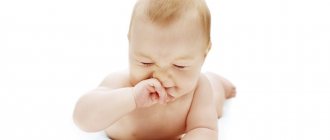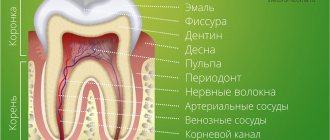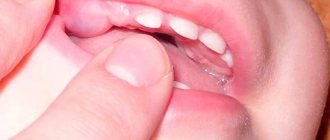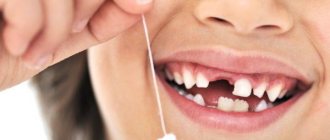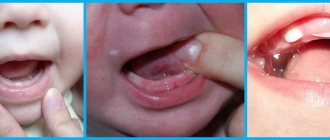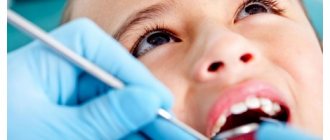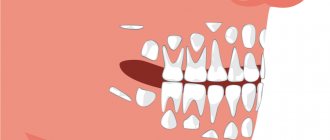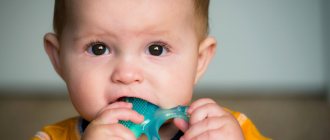Norm or pathology
Can teeth be cut at 3 months? The earliest age for the eruption of the first elements is considered to be three months of age. Dentists consider it normal for the first teeth to appear at 3 months of age. If the incisors appear earlier than the expected period, then the child should be shown to a therapist. The early appearance of elements on the surface of the gums may signal hormonal disruptions occurring in the body.
The appearance of baby teeth on the surface is accompanied by a number of distinctive symptoms:
- Pain in the gums. Because of this, the child puts fists and foreign objects into his mouth. At this moment, it is important for adults to ensure that there are no small toys or objects near the child that could get into the respiratory tract.
- Deterioration of the oral cavity. The gums swell and redden, becoming more sensitive to external irritants. In some cases, due to teething, the child may experience slight redness of the throat.
- Irritability and increased tearfulness of the baby. The symptom is associated with constant pain in the area of the eruption of the element. At this moment, children become more active and faster.
- Disorders of the digestive tract, manifested by loose stools, regurgitation, and rare bouts of vomiting.
- Temperature increase. The symptom is due to the fact that when teething, the newborn’s body is vulnerable to bacterial and viral pathogens.
What should you not do when your baby is teething?
- Strongly touch the child’s gums with your fingers, press on them and pick them out. This can increase pain or cause infection.
- Conduct vaccination, because immune system is weakened during this period .
- Without supervision, allow your child to chew any hard foods that could cause choking.
- Give homeopathic remedies. Not only will they not help the child, but they can cause serious harm.
The eruption of baby teeth is not a problem, but a natural process for a child’s body. But if you are not sure about something, do not hesitate to ask specialists. If you have any questions, write to us on Instagram.
Scheme for cutting elements for children
Dentists have drawn up a specific scheme for the formation of primary occlusion in children. However, it is necessary to remember that each baby’s body is individual, and the teething dates established by doctors may deviate up or down by several months. Pathological signs of bite formation in babies include early eruption of incisors (up to 3 months of age) and the complete absence of elements in the oral cavity by 12 months.
The standard scheme for the formation of bite in children is as follows:
- 5–7 months – lower front incisors;
- 8–10 – upper incisors;
- 10–12 – upper lateral incisors;
- 11–13 – lower lateral incisors;
- 12–15 – upper and lower molars;
- 17–22 – canines (upper, then lower);
- 25–30 – upper and lower molars.
Pattern of tooth growth in infants
If a child is cutting teeth at 3 months, then these should be the front pair of incisors. If the side elements are shown first, then it is necessary to show the baby to the dentist. The symptoms corresponding to the process depend on the characteristics of the child himself. In some children, the elements appear completely unnoticed, in others they cause crying, fever, etc.
Teething order
In what order and how do baby teeth erupt? This happens differently for each baby and at different times. But there is a generalized teething schedule:
Upper teeth
- Central incisors
(front teeth): 8–12 months.
- Lateral incisors
(teeth on either side of the front teeth): 9–13 months.
- Fangs
(pointed teeth on either side of the lateral incisors): 16–22 months.
- First molars
(back teeth used for grinding food): 13–19 months.
- Second molars
(posterior teeth filling the last gaps): at 25–33 months.
Lower teeth
- Central incisors
(front teeth): 6–10 months.
- Lateral incisors
(teeth on either side of the front teeth): 10–16 months.
- Fangs
(pointed teeth on either side of the lateral incisors): 17–23 months.
- First molars
(back teeth used for grinding food): at 14–18 months.
- Second molars
(posterior teeth filling the last gaps): at 23–31 months.
Alarming symptoms
Many signs of teething are harmless and go away on their own once the incisor comes to the surface. However, some signs may indicate the addition of bacterial or viral diseases against a background of weakened immunity.
Reviews of Dentokind for teething up to one year
Normal signs of the condition include:
- Profuse salivation. The symptom is observed in almost all children under three months. It does not require treatment for the child.
- Skin irritation near the chin. The symptom is caused by increased salivation during teething. It is enough to use an emollient cream every day at night to eliminate skin redness.
- The child's desire to breastfeed frequently. During feeding, the baby scratches its gums on the mother's nipple.
The list of alarming symptoms of teething includes:
- refusal to eat (more than 3-4 feedings);
- persistent diarrhea (may indicate an incipient intestinal infection);
- constant crying of the child.
Small bruises (hematomas) may appear in the eruption area. They dissolve quite quickly if you apply a compress to the problem area.
Baby teeth: interesting facts
Want to learn more about teething and baby teeth? Here are some fun facts about your baby's teeth:
- On average, about four baby teeth come out every six months. And this will continue until all 20 come out.
- Girls may start teething earlier than boys.
- The lower teeth usually erupt first.
- The first teeth usually erupt almost simultaneously on the right and left.
- Baby teeth are usually smaller and whiter than the permanent teeth that will replace them in a few years.
- From about age four, your child's face and jaw will begin to grow and change shape, and gaps will appear between the teeth. This is completely normal: it makes room in your mouth for larger adult teeth.
- At seven or eight years old, permanent teeth will begin to appear. Because it will take some time for a child to develop a full set of adult teeth, within a few years the child will have both baby and permanent teeth at the same time.
- Children only grow 20 baby teeth, and will have more molars. During adolescence or 20s, a child will have between 28 and 32 permanent teeth.
FREQUENTLY ASKED QUESTIONS
- Signs of teething:
Baby is cranky and in a bad mood. - The baby doesn't sleep well.
- Heavy salivation.
- The baby tries to chew objects and his fingers.
- The baby's gums are swollen.
- Give him a teether
Symptoms of teething include: bad mood and tearfulness, excessive salivation, swelling and redness of the gums. If you are not sure what explains your baby's discomfort, be sure to consult a doctor.
Signs of teething:
- The baby is whiny and capricious.
Factors affecting tooth growth
The speed of formation of a mixed bite depends on several circumstances:
- baby's genotype;
- performance of the thyroid gland;
- gender;
- severe infectious and viral diseases suffered in the past;
- duration of natural feeding;
- the presence of congenital diseases.
You also need to monitor the period of eruption of molars. They should come out to the surface of the gums only after the milk unit falls out. Otherwise, a mandatory visit to the dentist will be required. Early loss of milk elements is also undesirable, as this negatively affects the proportions of the baby’s jaw and his bite in the future.
How to care for baby teeth
It is important to start caring for your teeth as soon as your first teeth appear. Baby teeth will have to serve the baby for several years before they are replaced by molars. And teaching your baby to dental care rituals will help him properly take care of the health of his teeth and gums throughout his life. Preventing caries in baby teeth is just as important as it is in permanent teeth because caries can affect the development of molars and cause other dental problems such as pain and infections.
YOU MAY ALSO LIKE
First teeth
How to brush your child's teeth and take care of their health
Teeth cleaning
Regular brushing of baby teeth is a key part of dental care. Brush your baby's teeth twice a day with gentle movements and teach him to this mandatory ritual. Below we share tips on how to brush your baby’s teeth, as well as teach your child to do it themselves.
- Brush your teeth at least twice a day, and always brush your teeth after your child eats something sweet and after the last meal or drink of the day.
- Squeeze a little toothpaste with fluoride (from one year to one year you can just brush) onto a baby toothbrush with soft bristles. Brush each tooth thoroughly, trying to reach all surfaces. When your child is two years old, you can squeeze a pea-sized amount of toothpaste onto the brush. You will need to teach your child to rinse and spit rather than swallow the toothpaste.
- It doesn’t matter in which direction to clean. The main thing is to brush each tooth from all sides and reach the back teeth.
- At first, brushing your teeth will be entirely your responsibility. Toddlers should be gradually taught to brush their teeth on their own under your supervision. Until your child is seven or eight years old, supervise how he brushes his teeth. You might like some of these ideas for making brushing your teeth more fun.
BEST PRODUCT
Pampers® Active Baby Dry™
Nutrition
Your baby's diet is an important part of dental health. Avoid giving your child sugary drinks such as fruit juices and sodas, gum, toffee, and hard candy. Do not let your baby fall asleep with a bottle or sippy cup containing milk, formula, juice, etc., as this can cause the accumulation of sweet liquid in the mouth and lead to tooth decay.
Visits to the dentist
Regular dental checkups are of utmost importance to maintain your child's oral health. Typically, the first visit to the dentist should be around six months after the first tooth emerges, or when the child is 12 months old, whichever comes first.
But if you have any questions or concerns, contact your pediatric dentist—no matter the child’s age. Your pediatrician may also examine your gums and teeth during one of your regular checkups.
| Briefly |
How to care for baby teeth:
|
Reasons for the atypical timing of the eruption of elements
Only a dentist can accurately determine the causes of abnormal teething in children. However, there are several common violations that lead to the problem:
- improper metabolism;
- lack of calcium in the body;
- disturbances in the functioning of the endocrine system;
- gastrointestinal pathologies;
- incorrect direction of the tooth axis.
Anomalies of the dentition can be associated not only with the timing of the appearance of elements, but also with the color, location, and size of the units in the row. If a child is already born with teeth, they are usually removed. Such situations are diagnosed quite rarely, and they indicate intrauterine disorders in the baby.
First signs
It is advisable to recognize the onset of teething in a child in time in order to be able to provide him with the necessary help. As a rule, symptoms of the upcoming appearance of the first tooth in a baby appear within a few days - in most children this period lasts up to several days and ends with the eruption of the outer shell of the gums.
Parents can recognize that their baby is starting to teethe by the following signs:
- The appearance of sudden changes in the child’s behavior: sleep disturbance, irritability, crying, refusal to take the breast or pacifier;
- The formation of increased salivation, often accompanied by the appearance of rashes around the baby’s mouth, chin, and chest due to excessive saliva;
- At the site of tooth eruption, the gums swell and become swollen;
- The child bites everything that gets into his hands, trying to relieve the irritating itching that appears in the gums.
Ways to alleviate the condition
The formation of a bite is often accompanied by an increase in temperature. Therefore, parents should always have antipyretic drugs in their medicine cabinet (Panadol, Nurofen, Ibuklin). They not only reduce the temperature, but also relieve pain associated with tooth growth.
The love and attention of parents will allow the child to cope with the problem. The baby should be put to the breast and picked up as often as possible. Special teethers with gel will help satisfy your baby’s desire to scratch his teeth.
You need to choose small devices so that the child can comfortably hold it in his hand.
Pediatricians advise cooling teethers with cold water before giving them to a child. Instead of toys, you can give your baby chilled pieces of apple or carrot. At the same time, parents should carefully monitor that the baby does not bite off the product and does not choke on it. In parallel with this, local anesthetics can be used.
On the pharmacological market there are many drugs in the form of a gel that relieve pain during the appearance of teeth - Kalgel, Kamistad, Cholisal. Additionally, the gels have an anti-inflammatory effect, which also alleviates the child’s condition. The analgesic effect occurs 2-3 minutes after using the drug.
